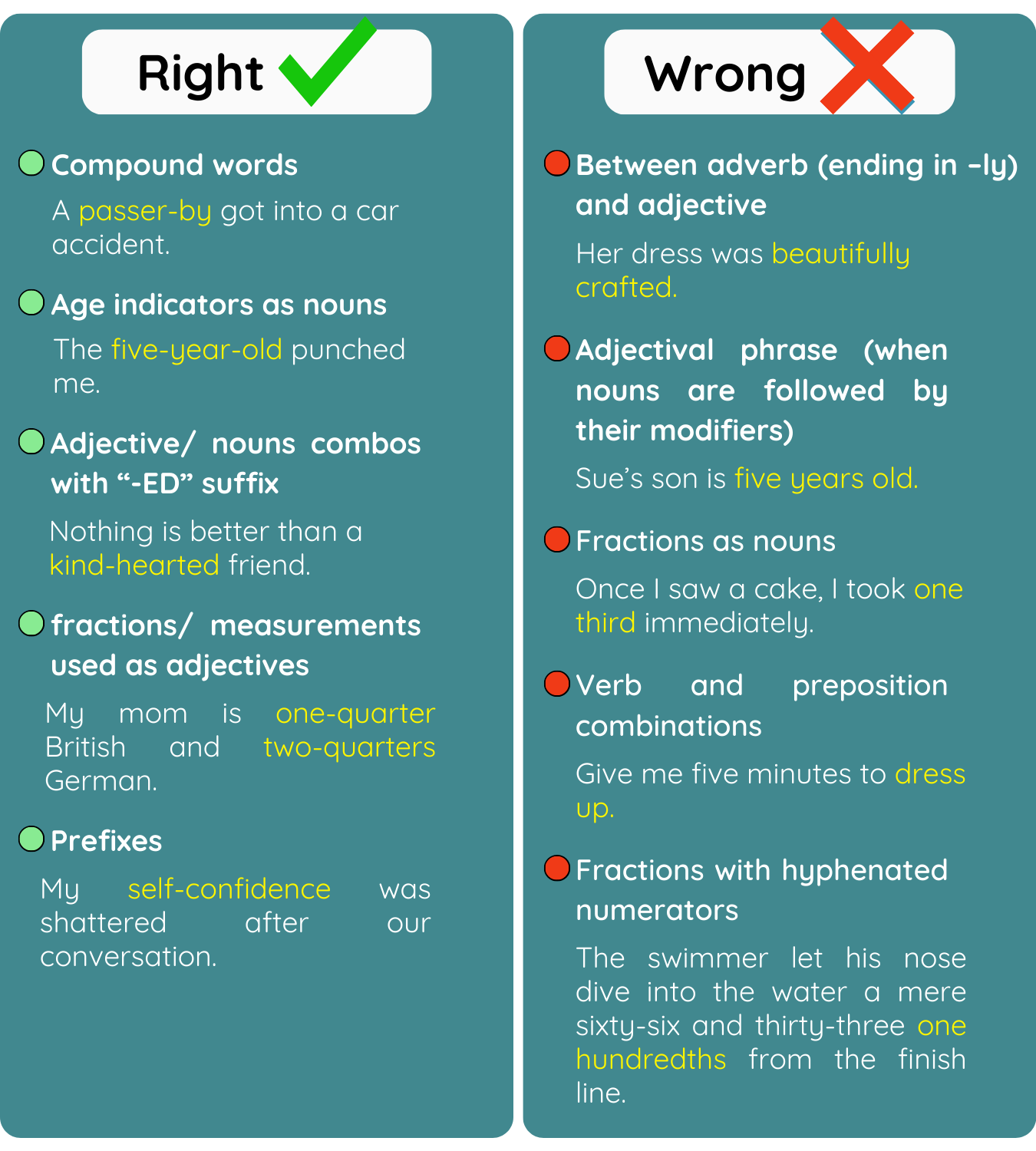Hyphens (-): General Principles of Use
The hyphen (-) is a short horizontal line placed within words. It shouldn’t be confused with the en dash (–) and the em dash (—) as it performs different functions in a sentence. It is a punctuation mark that aims to glue words together by building up compound words, linking words to prefixes, and highlighting word breaks. There are situations when you can decide whether to use a hyphen or not. In most cases, you will have to follow the general rules governing the use of hyphens when you write essays.
A Hyphen Is a Type of Dash?
A hyphen is a type of dash. But these punctuation marks aren’t interchangeable. They can’t be treated in the same way. They have different functions and different principles of use. To gain a general understanding of hyphens vs dashes, check the scheme below.

How and When to Use a Hyphen
Being a popular punctuation mark, a hyphen performs a wide range of functions. Despite having general principles of use, it is often applied in nonstandard and informal writing as a serious creative tool. Here is a quick overview of how hyphens are used:
Compound Words
A hyphen between words is the most common way of using this punctuation mark. It helps build up compound words, namely separate words that are joined together to deliver a new meaning.
Examples:
- ✔️ Easy-going
- ✔️ Check-in
- ✔️ Customer-friendly
Brits use hyphens in compound words more often than Americans. This way, they make the text more readable and showcase their writing skills at the same time.
Compound Modifiers
Compound modifiers are two words that are put together. They behave as one adjective for description purposes.
Examples:
- ✔️ A well-educated person knows how to behave in a situation like this.
- ✔️ A prize-winning performance deserves your attention.
- ✔️ A fair-haired woman entered the room.
Prefixes to Words
The words with prefixes like self-, all-, and ex- are not fully conjoined. The use of hyphens with prefixes can sort out this problem.
Examples:
- ✔️ Ex-boyfriend
- ✔️ Self-motivated
- ✔️ Non-English
There are some exceptions in words like unnatural, coordinate, or cooperate. If you have some doubts, don’t hesitate to use a good dictionary.
Suffixes to Words
The words with suffixes are not usually hyphenated. There are some exceptions for hyphens with suffixes like -style, -elect, -free, -based.
Examples:
- ✔️ Yoga-style dressings
- ✔️ Water-based cream
- ✔️ Caffeine-free drink
High or Low Words
You can use high or low to create compound words for description purposes. In this case, you will need to use a hyphen.
Examples:
- ✔️ The accident is high-impact.
- ✔️ The purchase was low-risk for their family budget.
- ✔️ The teacher was held in high-esteem.
Participles
A hyphen can be used with present participles (words ending in ‘ing’) and past participles. In this case, the participle and the adjective that you are about to combine should stand before the noun.
Examples:
- ✔️ A nice-looking house was located in front of the park.
- ✔️ A well-known actress is playing on the stage tonight.
If the noun stands in the first place, using a hyphen will be wrong. This is one of the most common hyphen mistakes that needs to be avoided.
Examples:
- ✔️ A house located in front of the park, it was nice looking.
- ✔️ An actress that is well known is playing on the stage tonight.
Numbers
When you write a number, instead of putting its digits, you should use a hyphen. You will have to do it whenever it comes to more than just one number.
Examples:
- ✔️ Twenty-seven
- ✔️ Thirty-one
- ✔️ Eighty-three
Fractions
If you aren’t expressing fractions as digits, you should use a hyphen.
Examples:
- ✔️ She ate two-thirds of the cake.
- ✔️ I have just spent one-quarter of my monthly salary.
- ✔️ The cake was cut into eight pieces. She took three-eighths for herself.
Spelled out Words
Sometimes in official or unofficial writing, you need to spell out a word. Whatever the case, you should use a hyphen between each letter to demonstrate that you are spelling out the word.
Examples:
- ✔️ “And what is your reference number,” the customer service agent asked.
- ✔️ “Michael.”
- ✔️ “And how am I spelling that?”
- ✔️ “M-I-C-H-A-E-L”
Multi-Syllable Words
Sometimes you need to demonstrate the number of syllables in a word. To highlight each particular syllable, you need to use hyphens.
Examples:
- ✔️ ha-zel-nut
- ✔️ No-vem-ber
- ✔️ won-der-ful
Stammers
In fiction writing, your character may speak with a stammer while being scared of something. Thus, you can achieve the effect of a trembling voice by using a hyphen.
Examples:
- ✔️ “I-I’m sorry, I d-didn’t want to disturb you.”
- ✔️ “Pl-please don’t m-make us do it!”
- ✔️ “I d-didn’t do m-my h-homework.”
Further Tips
Now that you know how and when to use a hyphen, you may get the last piece of idea on the given topic. These tips will help you avoid a confusing situation with this tricky punctuation mark.

It would be difficult to remember every rule related to a hyphen because there are so many ways to use them. The key takeaway is to know that hyphens are very different from dashes. If you look over this guide a few times though, you will gain a clear understanding of hyphens and their various uses.
